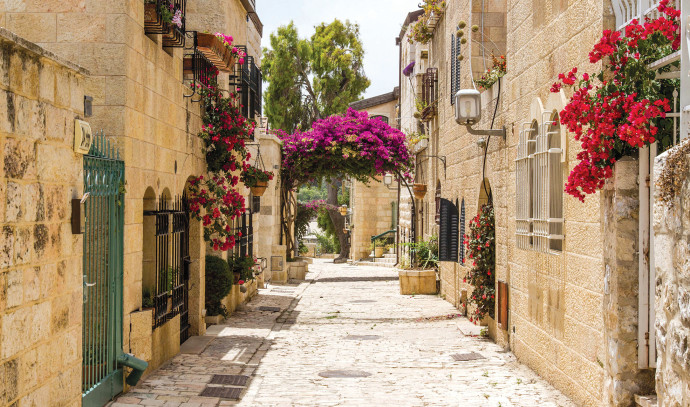In the heart of Jerusalem, where history whispers through cobblestone streets and the future beckons with modernity, lies Yemin Moshe, where past and present intertwine seamlessly.
A glimpse into history
Yemin Moshe traces its roots back to the early 1890s when the Montefiore Welfare Fund embarked on a visionary project to alleviate overcrowding and unsanitary conditions within Jerusalem’s Old City. Named in honor of British Jewish banker and philanthropist Moses Montefiore, the neighborhood’s moniker combines his first name with a verse from the Book of Isaiah.
Montefiore’s impact on the region extended beyond Yemin Moshe, as evidenced by the iconic Montefiore Windmill and the neighborhood of Mishkenot Sha’ananim, the first Jewish quarter constructed outside the Old City.
Nowadays, Yemin Moshe is one of Jerusalem’s more upscale neighborhoods in terms of real estate, surrounded by gardens with a panoramic view of the Old City walls.
Real estate resilience
Unlike the bustling metropolis that surrounds it, Yemin Moshe exudes a sense of tranquility and serenity. Its landscape reflects the neighborhood’s storied past, with charming older buildings and winding pathways that evoke a sense of nostalgia, as opposed to Jerusalem’s more modern neighborhoods full of new high-rise apartment blocks.
Despite its age, Yemin Moshe remains one of Jerusalem’s most coveted addresses, with property prices attesting to its enduring allure. While the neighborhood may lack the modern amenities of newer developments, its quaint charm and peaceful ambience more than compensate for any perceived shortcomings.
Navigating Yemin Moshe’s labyrinthine streets may require a willingness to forgo the convenience of vehicular access, but the reward is an oasis of serenity nestled amid the bustling cityscape. With limited car access and an abundance of stairs, the neighborhood offers respite from the hustle and bustle of urban life, inviting residents to embrace a slower pace and savor the simple joys of community living.
Its views of the Old City and the peaceful gardens have made Yemin Moshe a popular spot for wedding photo shoots among younger couples; and with the nearby Artists’ Colony, the neighborhood has many artistic workshops for all to get involved.
The legacy of the Montefiore Windmill
Built in 1857 by Montefiore, the windmill was a beacon of hope amid the tumultuous landscape of Ottoman-ruled Palestine. It was designed as a flour mill on a slope opposite the city walls to provide the residents with some form of self-sufficiency. Its construction heralded a new era of progress and prosperity for the burgeoning Jewish community.
However, its significance transcends mere functionality, serving as a symbol of defiance during times of conflict. During the 1948 blockade of Jerusalem, the windmill became a strategic vantage point for Hagana fighters, who utilized its towering height to survey enemy movements.
British authorities ordered the windmill’s destruction, but fate intervened in a twist of irony. Tasked with its demolition, soldiers from Montefiore’s hometown of Ramsgate, upon seeing his name displayed on a plaque, chose to preserve the structure, sparing it from destruction. Today, the windmill stands as a landmark and museum.
Mishkenot Sha’ananim
Established in 1860 by Montefiore, Mishkenot Sha’ananim marked a significant milestone in the city’s evolution, serving as the first Jewish enclave built outside the Old City walls. Its name, meaning “peaceful dwellings,” reflects its lofty aspirations of fostering harmony and unity within the community.
Over the years, Mishkenot Sha’ananim has evolved into a vibrant hub of creativity and intellectual exchange, attracting renowned authors, artists, and musicians.
Today, Mishkenot Sha’ananim houses the Jerusalem Music Center and serves as a convention center for international gatherings. As a symbol of cultural diplomacy and artistic expression, it remains a cherished landmark of Jerusalem.■




